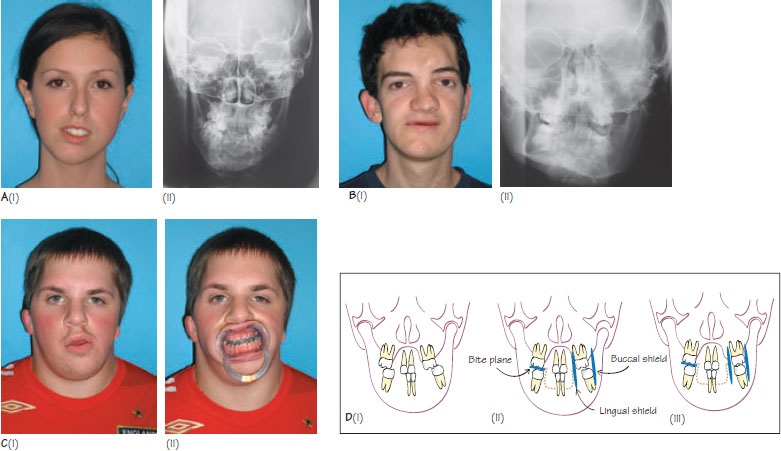25
Asymmetries
Figure 25.1 (A) A case of left-sided hemimandibular elongation. Note the significant lateral displacement of the chin point towards the unaffected side. (B) A case of left-sided hemimandibular hyperplasia. Note the extensive vertical component of growth, with minimal displacement of the chin point, and a twisted appearance to the chin. (C) (i) A patient with left sided hemifacial microsomia, (ii) Note the severe cant in the maxillary occlusal plane due to underdevelopment of the left side mandibular ramus. (D) The use of a hybrid functional appliance to maximise growth, (i) A left-sided mandibular deficiency with resultant displacement of the chin point, dental centreline and maxillary occlusal cant, (ii) Insertion of a hybrid functional appliance constructed with the centrelines corrected and left condyle distracted. A bite plane is used to prevent eruption of the right molars whilst disocclusion encourages eruption of the left molars. The lingual shield prevents interpostion of the tongue that may limit eruption and the buccal shield encourages unilateral expansion. (iii) The desired end result.

Symmetry is defined as correspondence in size, shape and relative position of parts on opposite sides of a median plane. The facial midline is usually taken as a line passing through soft tissue nasion and the midpoint of the upper lip. A degree of facial asymmetry is normal and acceptable across this line. It can be caused by an asymmetry in the facial skeleton and/or soft tissue drape. The point at which an asymmetry becomes unacceptable is when an individual begins to have aesthetic concerns and/or functional limitations. There is individual variation regarding when this point is reached. Although asymmetries can occur at many levels of the face, this chapter will mainly focus on developmental asymmetries affecting the mandible and maxilla. Table 25.1 provides a classification of asymmetries.
Developmental causes
Hemimandibular elongation and hyperplasia
Hemimandibular elongation is a developmental deformity, of unknown aetiology that usually affects one side of the mandible and presents with a progressively increasing transverse displacement of the chin that often becomes apparent during or after the adolescent growth spurt (Figure 25.1A). The mandibular dentition follows the skeletal displacement, which predisposes to buccal crossbite and centreline displacement away from the affected side and a scissor bite on the affected side. Since there is a minimal vertical component to the abnormal growth pattern, there is typically no over-eruption of the maxillary dentition on the affected side.
Table 25.1 Classification of mandibular/maxillary asymmetries based on aetiology.
| Cause | Examples |
| Developmental | Hemimandibular elongation and hyperplasia Hemifacial microsomia Hemimandibular atrophy Hemifacial hypertrophy Torticollis Hemifaci/> |
Stay updated, free dental videos. Join our Telegram channel

VIDEdental - Online dental courses


